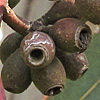Eucalyptus cladocalyx (sugar gum) is a tall tree, where half or even more of its height is taken up by the trunk and the leafless steep branches. Only the ends of the steep branches divide into round secondary crowns that are separate from each other and carry the foliage.
Sugar gum is used in forestation for excellent wood production for the manufacture of poles and also for furniture, and as a windbreaker.
Sugar gum reaches a height of 35 m and its diameter at breast height can reach 1.5 m. The bark is scaly, brown-red with gray spots. The wood of sugar gum is yellowish to brown, and hard, but is easily given to processing and making furniture. This makes this eucalyptus the preferred tree for wood production plantations in Australia.
The juvenile leaves are alternate and ellipsoidal. The mature leaves are alternate, lanceolate and dark green. The leaves contain cyanic acid and are toxic to animals. This protects saplings and young trees from grazing and from being devoured by insects.
Sugar gum, like the entire family, carries bisexual flowers. The inflorescence umbels have 4-16 creamy-white flowers which are carried on a round pedicel. The nectar-rich flowers attracts bees, and this is the origin of its common name – sugar gum. The flower bud is elongated, with a short apex at its tip. The stamen’s operculum is semicircular, somewhat flattened, and creates small margins outside the flower bud, and has a protrusion at its center. The operculum is shed when the stamens straighten and push it outwards, when the typical flower, which lacks petals, is revealed. The operculum is the characteristic part and affords the genus Eucalyptus its name. The origin of the name in Greek is eu-kaluptos, which means “well covered”.
The fruits are shaped like a truncated spindle and are 1 cm long. The seeds are tiny (about 150 viable seeds per gram).
The meaning of the name cladocalyx in Latin is “defeat of the goblet”, which apparently refers to the shape of the fruit. Sugar gum blooms in the summer, which in Australia is in January-February, and in Israel in May-September.
Sugar gum is endemic to the territory of Southern Australia in three separate habitats which are close to the shore. In one of the habitats, in the Eyre Peninsula, the trees are relatively small and reach a height of only 15 m and a maximal diameter of 0.4 m. In two of the habitats, in the Eyre Peninsula and in Flinders Ranges, the trees grow at the tops of slopes and peaks up to an altitude of 600 m, whereas on Kangaroo Island they are found in watercourses. The soil on the ridges and peaks is poor and contains quartz minerals and iron, whereas in rivers the soil is alluvial and originates from limestone and iron rocks. Rain falls there in the winter, and reaches 375-625 mm annually. The average temperature in the dry season (4 months) is 23-30C, and in the winter 4-8C, with 20 days of frost at most.
In Israel, the rate of survival is low, although in acclimatization plots the trees that survived reached large dimensions. Because of the low survival rate, its planting in KKL (Jewish National Fund) forests is limited to areas which receive over 300 mm rain, where it is planted in small numbers. Large and conspicuous trees are found in the Golan Heights, the Hula Valley, the Galilee, in Ma’ale Hachamisha, Ilanot and Eshtaol and in Limans in the Beer-Sheva region.
Sugar gum belongs to the Myrtaceae family which includes 5650 species of evergreen woody plants in 130-150 different genera, where the most familiar of these are the myrtle, the guava, the feijoa and the callistemon. The genus Eucalyptus includes about 700 species and today it is the most commonly planted genus for wood production in commercial plantations around the world.
Written by Zvi Avni







